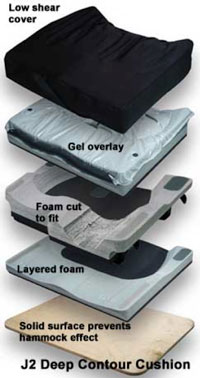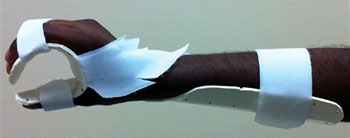Following a stroke, many patients require assistive devices, adaptive equipment, mobility aids, wheelchairs, and orthotic devices to maximize independent functioning. The type and level of functional deficit, the amount of learned adaptation, and the structural characteristics of the living environment determine the need for a particular device.
Walking and Mobility Devices
Walking and mobility devices are helpful for patients with mild to moderate gait impairments. These devices increase the base of support and reduce the effort needed to walk.
Canes and Walkers
Canes and walkers are commonly used as a safety device to aid balance and prevent falls during walking. From a motor control standpoint, these devices may have an adverse effect on the recovery of balance following a stroke. The use of a cane during walking causes a person’s center of gravity to shift in the direction of the cane, reduces postural sway, and increases asymmetrical alignment. Both canes and walkers also interfere with compensatory stepping responses (Shumway-Cook & Woollacott, 2012).
When a walker is used, the body largely abandons the ankle strategy and relies heavily on the hip strategy for balance. This dependence on the hip strategy for balance paradoxically may lead to a decrease in ankle sway and contribute to further decline in balance due to loss of ankle strength and flexibility. For this reason the pros and cons of cane and walker use must be carefully considered before a device is recommended for full-time use.
Wheelchairs
Wheelchairs are often provided for patients with severe motor weakness or for those who easily fatigue. Chair design and options vary widely and a wheelchair prescription should be specific to the patient’s needs and environment and to patient and caregiver preferences.
Companies such as Invacare and Quickie make inexpensive wheelchairs with prices ranging from as low as $150 up to just under $400–$500 for this category of chair. The common feature of these inexpensive chairs is the lack of options for sizing and seating. The chairs are available in standard widths of 16“ and 18”—often too wide for the average adult user—especially older and smaller adults.
Consideration must be given to the comfort of the person using the chair. Poor fit leads to more than discomfort—it increases the risk of skin breakdown, can cause back and shoulder injuries, affects a person’s ability to propel the chair independently, and contributes to loss of mobility and independence.
Deep Contour Cushion System

The J2 deep contour cushion. Note the solid base combined with layered, high-density foam and a gel overlay. The gel is contained in multiple small packets to prevent bottoming out. The foam can be cut by the clinician for custom fitting. Courtesy of Sunrise Medical Corporation.
Special attention should be paid to the seat and back of a wheelchair. Over time, the seat and back begin to sag, or “bottom out.” A sagging seat greatly increases risk for skin breakdown, especially if a person sits in the chair for a long period of time. The thighs tend to roll inward, exposing the trochanters of the femur to pressure from the sides of the wheelchair. The pelvis tends to tilt backwards and flatten, causing the spine to slouch and round and increasing the tendency to slide forward in the chair. This places pressure on the ischial tuberosities (sit bones) and on the rounded mid-thoracic spine, and places a constant shear force on the skin of the buttocks, thighs, and thoracic spine.
One of the most important goals of pressure reduction—whether in a bed, chair, or wheelchair—is to distribute weight as evenly as possible with good skeletal alignment. Placing a foam or gel cushion on a sagging wheelchair seat may not solve the problem. One answer is to replace the sagging seat with a solid seat and cover it with the appropriate pressure-reducing or pressure-relief cushion.
There are a number of basic principles regarding seat depth, height, width, and length, footrest height, back support, and seat-to-back angle that should be considered to attain a correct body position. As a quick checklist when positioning a client, clinicians can look at a seated client and ask themselves the following questions: Is the client sitting in midline or are they slouched or leaning to one side? Are the client’s knees higher than the hips, causing increased pressure on the sacrum? Are the chair arms or footrests causing pressure marks on the client’s skin? If yes, correct the client’s position.
Under certain circumstances, Medicare may cover the cost of a wheelchair rental or purchase for home use. The coverage is limited—generally only for standard wheelchairs with a width of 16 or 18 inches. Medicare does not usually cover the cost of seat cushions or custom backrests. Customized seating systems can be more than the cost of the wheelchair and are usually paid for by the client.
If the chair is going to be used often, fit is critical. Wheelchairs should not take the place of a good chair and should not be used as a primary seating option without careful consideration of fit, comfort, and pressure relief.
Eating, Bathing, and Grooming
An array of adaptive devices is available for eating, bathing, grooming, and dressing for patients with functional limitations. Many patients may need to use adaptive devices in the weeks following a stroke, but will not require them for long-term use. This should be taken into account when considering a device. Assistive and adaptive devices include:
- Eating devices
- Eating utensils with built-up handles
- Rocker knives
- Plate guards
- Non-skid place mats
- Bathing and grooming devices
- Long-handled sponges for bathing
- Hand-held showers
- Tub and shower chairs
- Toileting aids
- Elevated toilet seats
- Grab bars
- Transfer devices
- Transfer board
- Safety poles
- Hydraulic lifts
Orthotics
Lower extremity orthotics (eg, ankle-foot and knee-ankle-foot orthotics) can be effective in patients with persistent weakness and instability at the ankle or knee joint. Orthotics can facilitate gait training and should be considered early in the rehabilitation process to permit gait training as early as possible.
An orthotic should not be used as a substitute for functional exercise directed at regaining muscle strength and control, particularly if the prognosis for motor recovery is good. Prefabricated orthotics can be used in the early stages of gait training, but a custom-fit device should be provided if it is determined that the patient may require long-term use of the orthotic (VA/DOD, 2010).
Positioning devices are used to rest joints, reduce strain on a paretic or spastic joint, provide support, or help regain function.
Wrist-Hand Positioning Device

Custom-made dorsal forearm-based wrist-hand splint used to place the wrist in a resting position of approximately 30 degrees of extension. Source: NIH, n.d.
